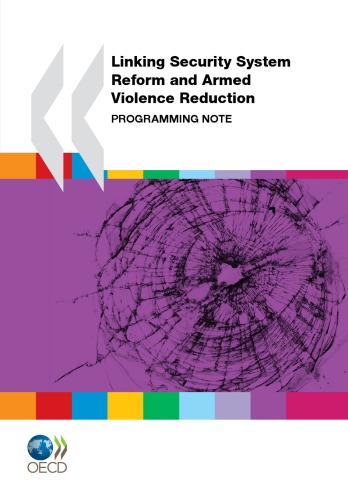

Most ebook files are in PDF format, so you can easily read them using various software such as Foxit Reader or directly on the Google Chrome browser.
Some ebook files are released by publishers in other formats such as .awz, .mobi, .epub, .fb2, etc. You may need to install specific software to read these formats on mobile/PC, such as Calibre.
Please read the tutorial at this link: https://ebookbell.com/faq
We offer FREE conversion to the popular formats you request; however, this may take some time. Therefore, right after payment, please email us, and we will try to provide the service as quickly as possible.
For some exceptional file formats or broken links (if any), please refrain from opening any disputes. Instead, email us first, and we will try to assist within a maximum of 6 hours.
EbookBell Team

4.0
36 reviews
ISBN 13: 9789264107212
Author: OECD
Foreword Armed violence is an everyday reality for millions of people around the globe. More than 700 000 people die as a result of armed violence each year. Many more experience traumatic loss in their families and are left with lasting psychological and physical scars. The impact of armed violence extends further, negatively influencing development, peace and good governance, often by creating a climate of impunity, corruption and by undermining public institutions. It is also closely tied with transnational crime and the misery and abuse associated with the illegal trafficking of arms, drugs and people. Finally, the economic impact of armed violence is striking with the cost of lost productivity due to non-conflict armed violence alone estimated to cost upwards of USD 95 billion annually worldwide. This violence has important youth and gender dimensions. The majority of perpetrators and victims are men, while women and girls are at greater risk of violence that is less visible and committed in the private sphere, including intimate partner violence, child abuse, sexual and gender based violence. Measures at reducing armed violence are therefore also measures at reducing human suffering. The OECD DAC policy paper Armed Violence Reduction: Enabling Development, published in 2009, acknowledged as a challenge the increased levels of armed violence in non-conflict countries, the increasing linkage between conflict and crime, rapidly growing youth populations in the south and accelerating levels of unregulated urbanisation. The paper provided a methodology to help donors tackle the programming challenging of reducing armed violence. Building on the OECD DAC policy paper, three programming notes were developed to contribute to our understanding of specific types of armed violence: Youth and armed violence, armed violence in urban areas and Security System Reform in relation to Armed violence reduction. Each note aims to improve our understanding of these dynamics while also offering practical assistance on assessments, programme design, risk management, monitoring and evaluation, as well as on entry points for direct and indirect programming. 2011 is an important year for global efforts at Armed violence reduction with a series of regional best practice seminars as well as the high-level
1. The Concepts of Security System Reform (SSR) and Armed Violence Reduction (AVR)
Security System Reform
Armed Violence Reduction
Conceptual Synergies between AVR and SSR
2. Assessment and Design
Applying the Armed Violence Lens in SSR Assessments
Innovative Assessment Techniques
Programme Design
3. Synergies between AVR and SSR Programming Activities
AVR Emphasis in SSR
Complementary AVR and SSR Programming
4. Entry Points
SSR as an Entry Point for AVR
AVR as an Entry Point for SSR
5. Monitoring and Evaluation
Developing Indicators
Involving Local Stakeholders: Ownership and Frontline Capacities
conflict between liberty and security
security and development in fragile and conflict affected areas
conflict security and peace
fragility conflict and violence
fragile and conflict affected situations
a conflict scenario virulence
a security dilemma occurs when